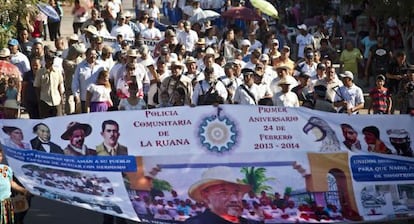Michoacán’s vigilantes divided on eve of disbandment deadline
Violence continues to grip the Mexican state despite government sweep against drug cartel


The civilian self-defense patrols in Michoacán, in western Mexico, have their hours numbered.
The viligante movement that sprung up spontaneously in February 2013, after local residents got tired of putting up with the abuses of organized crime gangs, will formally disband on Saturday, when the federal government’s deadline for “laying down their arms” expires.
The government’s security envoy in Michoacán, Alfredo Castillo, warned this week that the deadline would not be extended.
The date finds the vigilantes grappling with infighting. On Friday the head of the Tepalcatepec division, José Manuel Mireles, was expelled from the movement’s top body, the General Council of the Self-Defense Groups.
“What is taking place on the 10th is that we are changing our t-shirts, but the fight remains the same,” said Mireles in a recent interview. “Our vehicles will no longer read ‘self-defense groups’ but ‘rural police’ instead.”
We are changing our t-shirts, but the fight remains the same”
But trading in their trademark yellow bandanas and white tees for official uniforms will not be the only change. Beginning on Sunday, anyone found in possession of an unlicensed weapon will be arrested.
“The date is simply a starting point for a return to order, for the comunitarios to resume their roles as citizens, as established by law, and for the government to fulfill its duty to guarantee security,” says Erick López Barriga, a former federal deputy and former technical secretary in the state government who is now a researcher at University of California, Berkeley.
To date, the National Defense Secretary’s Office has received, registered and returned 6,086 weapons in its bid to create a database of the self-defense groups’ arsenal, which is reportedly state-of-the-art.
As of Thursday, 3,316 people had applied to join the Rural Force in Michoacán, which will allow them to actively participate in community security, though without receiving payment for their services. While the exact number of vigilantes is unclear, as no official records exist, leaders at one point spoke of around 15,000 individuals.
Meanwhile, the situation in Michoacán is anything but clear. In just 120 days, the mission sent by President Enrique Peña Nieto has managed to arrest most of the leaders of the Caballeros Templarios (Knights Templar) drug ring, with the notable exception of Servando Gómez, aka La Tuta.
Legal action has also been initiated against several mayors, while a few higher-ranking politicians have been sent to jail, including Jesús Reyna, former interim governor and government secretary in Michoacán, who was found to have ties to organized crime.
The social fabric is still fractured, conditions for economic development are still negative, and government structures remain broken”
The presence of military patrols and federal police has also helped unblock roads and entire regions that had been off limits to local residents for months. In Lázaro Cárdenas, a strategic port on the Pacific that had been under Templar control until November, authorities seized illegal mines. In early February President Peña Nieto announced a $3.4-billion investment to help Michoacán, the highest figure ever earmarked for a Mexican state.
Yet national security data shows that the violence has not ended. Between January and March, intentional homicides rose 55 percent compared with the same period in 2013 (272 cases, up from 175). There was also a rise in violent robberies, nearly twice as many cases of cattle rustling, and more reports of kidnapping and rape.
Estanislao Beltrán, the spokesman for the vigilantes, told a local newspaper that part of the criminal ring’s structure has not been busted but simply moved nearby, mostly to Mexico State. Some reports suggest a new cartel named La Tercera Hermandad (or The Third Brotherhood) has sprung up with support from Nueva Generación, a drugs gang from the nearby state of Jalisco.
Although Saturday will be a turning point in the conflict, there are still many loose ends.
“The social fabric is still fractured, conditions for economic development are still negative, and government structures remain broken,” reflects López Barriga. “It will be difficult to disarm all the self-defense groups in the short term, and it will be equally complicated for the government to effectively guarantee security across the state.”
Tu suscripción se está usando en otro dispositivo
¿Quieres añadir otro usuario a tu suscripción?
Si continúas leyendo en este dispositivo, no se podrá leer en el otro.
FlechaTu suscripción se está usando en otro dispositivo y solo puedes acceder a EL PAÍS desde un dispositivo a la vez.
Si quieres compartir tu cuenta, cambia tu suscripción a la modalidad Premium, así podrás añadir otro usuario. Cada uno accederá con su propia cuenta de email, lo que os permitirá personalizar vuestra experiencia en EL PAÍS.
¿Tienes una suscripción de empresa? Accede aquí para contratar más cuentas.
En el caso de no saber quién está usando tu cuenta, te recomendamos cambiar tu contraseña aquí.
Si decides continuar compartiendo tu cuenta, este mensaje se mostrará en tu dispositivo y en el de la otra persona que está usando tu cuenta de forma indefinida, afectando a tu experiencia de lectura. Puedes consultar aquí los términos y condiciones de la suscripción digital.








































